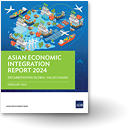Sep
2011
The Greater Mekong Subregion (GMS)

The Greater Mekong Subregion (GMS) comprises Cambodia, PRC (Yunnan province and Guangxi Zhuang Autonomous Region), Lao People’s Democratic Republic (Lao PDR), Myanmar, Thailand, and Viet Nam. In 1992, GMS, with ADB support, launched the GMS Program of economic cooperation—now covering nine sectors: agriculture, energy, environment, human resource development, investment, telecommunications, tourism, transport, and trade. The GMS Strategic Framework, 2002–2012, envisions an integrated, prosperous, and harmonious subregion through increased connectivity, improved competitiveness, and a greater sense of community.
Recent Developments
 New GMS Strategic Framework (SF) being finalized. The new SF supports initiatives to help transform GMS transport corridors into fully fledged economic corridors within 10 years. These include multi-sector infrastructure investment linked to urban and rural development, greater focus on policies increasing infrastructure efficiency, and dealing with social and environmental concerns. GMS ministers backed the SF during their 17th Ministerial Conference 2–4 August and will be formally endorsed during the 4th GMS Leaders’ Summit in December 2011.
New GMS Strategic Framework (SF) being finalized. The new SF supports initiatives to help transform GMS transport corridors into fully fledged economic corridors within 10 years. These include multi-sector infrastructure investment linked to urban and rural development, greater focus on policies increasing infrastructure efficiency, and dealing with social and environmental concerns. GMS ministers backed the SF during their 17th Ministerial Conference 2–4 August and will be formally endorsed during the 4th GMS Leaders’ Summit in December 2011.- Other key initiatives to be presented at the 4th GMS Summit include (i) the 2012–2016 Core Environment Program, (ii) an agreement to cooperate on accelerating construction of an Information Superhighway Network, (iii) a refocused tourism strategy, (iv) a plan for a GMS Railway Coordination Office, and (vi) a progress report on transport and trade facilitation.
The views expressed in this blog post are the views of the author and do not necessarily reflect the views or policies of ARIC, the Asian Development Bank (ADB), its Board of Directors, or the governments they represent. ARIC does not guarantee the accuracy of the information and data included in this blog post and accepts no responsibility for any consequences of their use. Terminology used may not necessarily be consistent with official ADB terms.




